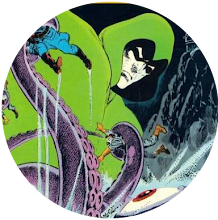I must confess that, in my younger days, I was quite the fan of the theories of Erich Von Däniken.
Those theories stated, of course, that virtually every building constructed before 1950 was put there by aliens.
Granted, over the years, some individuals have striven to debunk such theories by pointing out that they make no sense and that there's no evidence at all to back them up.
To which I can only reply, "Yah boo sucks. What sort of spoilsport ruins a good theory by inflicting the truth on it?"
Thus it is that issue #145 of The Incredible Hulk has always been a favourite of mine.
In it, our green-skinned hero manages to land a part in a movie - only (after reverting to Bruce Banner) to be kidnapped by aliens bearing a remarkable resemblance to ancient Egyptian gods.
It turns out that, thousands of years ago, they visited the Earth and planted seeds in the desert sand; seeds destined to mature into giant stone monsters that'll fight each other in order to settle some parochial dispute or other.
Needless to say, Bruce Banner's not settling for that. As we all know, it's his job to smash everything to smithereens, and he's not letting anyone else get in on the action.
So, he sabotages the activation of one monster (the Sphinx) and then, in his Hulk form, is returned to Earth to fight the other monster (the Colossus) as the aliens flee our world in a panic.
Needless to say, the Hulk quickly deals with the Colossus and then strolls off, bemoaning the fact that nobody wants to be his friend.
It has to be said that, in the course of this tale, he does sink a ship and murder its entire crew and also destroys a village by accidentally inflicting tidal waves upon it. So you can easily see why he's not quite as popular as he'd like to be.
The fight itself is an odd thing, bearing a noticeable resemblance to the scene in Monty Python and the Holy Grail where the Black Knight refuses to admit he's seriously injured as yet more and more parts of him get chopped off.
Likewise, no matter how many bits of his stone opponent the Hulk smashes to pieces, it carries on declaring that it's still on course for a magnificent triumph. It may not be too bright but it is at least an optimist.
The fight's also a little odd because one of the onlookers bears a striking resemblance to Betty Ross while another looks exactly like her father, which creates a very strange sensation as you read the panels in question.
Speaking of the Ross family, I do believe this to be the issue where the Hulkbuster base makes its conceptual debut, as Thunderbolt outlines his plans for it, complete with its layout which, bizarrely, is clearly modelled on the CND symbol.
Well, Thunderbolt Ross might not like the Hulk (or, seemingly, nuclear weapons) but I do still love this tale even though, as an adult, I can see that the aliens' behaviour lacks a certain something in the logic department. Just why does it take thousands of years for their creations to reach maturity and just why did they bring Bruce Banner aboard their spaceship and then leave him unsupervised so he could wreck their plans?
These are all mysteries.
They're mysteries as great as those of Von Däniken himself and so may find themselves buried forever beneath the sands of enlightenment, never to be unearthed.
But, let's face it, that's the best kind of mystery - the kind that never gets answered.
Subscribe to:
Post Comments (Atom)












































































6 comments:
Wait a minute. I thought the Sphynx was Pharaoh Rama-Tut's time machine? Why can't they pick one and stick to it! Bah!
(Or Sphinx if you prefer.)
Also, I seem to remember actual Egyptian gods turning up in Thor around this time, which would make fake von Daniken style deities a bit pointless.
-sean
Kid, I always spell sphinx with a Y. It always disappoints me when my spellchecker (and Wikipedia) tells me I'm wrong.
Sean, and then there's the alternative versions of the Greek gods in The Eternals, when there are already real Greek gods in the Marvel universe.
Yeah, Steve, but it seems clear that the Eternals was intended as a self contained work, not set in the Marvel Universe (despite what some later Marvel comics would have us believe)
Having said that, I'm not actually too bothered by lapses in continuity as long as the results are good, and Kirby's singular approach is just a lot more entertaining than yet more generic Marvel villains. But others may disagree.
-sean
My impression was that "The Eternals" was originally intended as a self-contained series, but they encountered some S.H.I.E.L.D. agents in one issue, so that brought them into the 616 (or whatever) universe.
IIRC, sometime around 1979-80, Marvel adopted an official policy that all of their titles had to tie in with each other (except maybe for licensed properties like Star Trek and Star Wars), so Thor #290-300 or so had a long arc that fit the Eternals in with Marvel's already-existing versions of Asgardian and Olympian gods.
Post a Comment